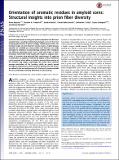| dc.contributor.author | Reymer, Anna | |
| dc.contributor.author | Frederick, Kendra K. | |
| dc.contributor.author | Rocha, Sandra | |
| dc.contributor.author | Beke-Somfai, Tamas | |
| dc.contributor.author | Kitts, Catherine C. | |
| dc.contributor.author | Lindquist, Susan | |
| dc.contributor.author | Norden, Bengt | |
| dc.date.accessioned | 2015-06-15T17:24:18Z | |
| dc.date.available | 2015-06-15T17:24:18Z | |
| dc.date.issued | 2014-12 | |
| dc.date.submitted | 2014-08 | |
| dc.identifier.issn | 0027-8424 | |
| dc.identifier.issn | 1091-6490 | |
| dc.identifier.uri | http://hdl.handle.net/1721.1/97422 | |
| dc.description.abstract | Structural conversion of one given protein sequence into different amyloid states, resulting in distinct phenotypes, is one of the most intriguing phenomena of protein biology. Despite great efforts the structural origin of prion diversity remains elusive, mainly because amyloids are insoluble yet noncrystalline and therefore not easily amenable to traditional structural-biology methods. We investigate two different phenotypic prion strains, weak and strong, of yeast translation termination factor Sup35 with respect to angular orientation of tyrosines using polarized light spectroscopy. By applying a combination of alignment methods the degree of fiber orientation can be assessed, which allows a relatively accurate determination of the aromatic ring angles. Surprisingly, the strains show identical average orientations of the tyrosines, which are evenly spread through the amyloid core. Small variations between the two strains are related to the local environment of a fraction of tyrosines outside the core, potentially reflecting differences in fibril packing. | en_US |
| dc.description.sponsorship | King Abdullah University of Science and Technology (Grant KUK-11-008-23) | en_US |
| dc.description.sponsorship | European Research Council (Grant EC-2008 AdG 227700-SUMO) | en_US |
| dc.description.sponsorship | Swedish Research Council (Linnaeus Grant SUPRA 349-2007-8680) | en_US |
| dc.description.sponsorship | Howard Hughes Medical Institute | en_US |
| dc.description.sponsorship | National Institutes of Health (U.S.) (Grant GM025874) | en_US |
| dc.language.iso | en_US | |
| dc.publisher | National Academy of Sciences (U.S.) | en_US |
| dc.relation.isversionof | http://dx.doi.org/10.1073/pnas.1415663111 | en_US |
| dc.rights | Article is made available in accordance with the publisher's policy and may be subject to US copyright law. Please refer to the publisher's site for terms of use. | en_US |
| dc.source | National Academy of Sciences (U.S.) | en_US |
| dc.title | Orientation of aromatic residues in amyloid cores: Structural insights into prion fiber diversity | en_US |
| dc.type | Article | en_US |
| dc.identifier.citation | Reymer, Anna, Kendra K. Frederick, Sandra Rocha, Tamas Beke-Somfai, Catherine C. Kitts, Susan Lindquist, and Bengt Norden. “Orientation of Aromatic Residues in Amyloid Cores: Structural Insights into Prion Fiber Diversity.” Proceedings of the National Academy of Sciences 111, no. 48 (November 17, 2014): 17158–17163. | en_US |
| dc.contributor.department | Massachusetts Institute of Technology. Department of Biology | en_US |
| dc.contributor.department | Whitehead Institute for Biomedical Research | en_US |
| dc.contributor.mitauthor | Lindquist, Susan | en_US |
| dc.relation.journal | Proceedings of the National Academy of Sciences | en_US |
| dc.eprint.version | Final published version | en_US |
| dc.type.uri | http://purl.org/eprint/type/JournalArticle | en_US |
| eprint.status | http://purl.org/eprint/status/PeerReviewed | en_US |
| dspace.orderedauthors | Reymer, Anna; Frederick, Kendra K.; Rocha, Sandra; Beke-Somfai, Tamas; Kitts, Catherine C.; Lindquist, Susan; Norden, Bengt | en_US |
| dc.identifier.orcid | https://orcid.org/0000-0003-1307-882X | |
| mit.license | PUBLISHER_POLICY | en_US |
| mit.metadata.status | Complete | |
